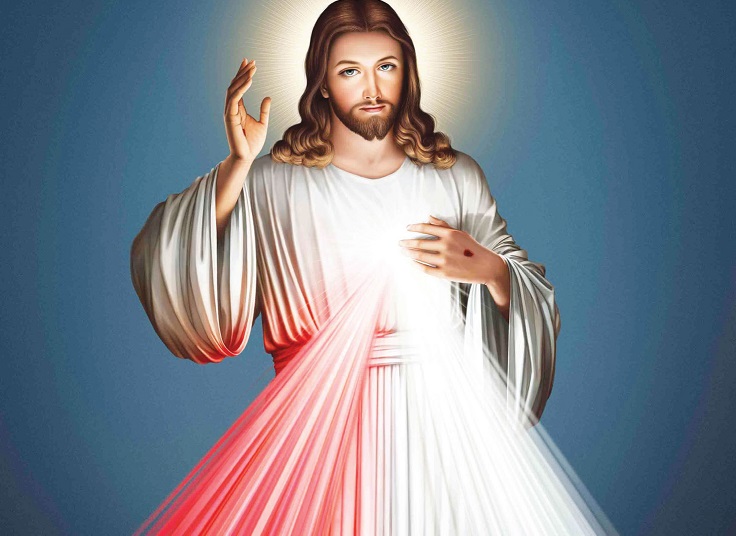Hope in the endless ocean of divine mercy
Divine Mercy flows like an endless ocean, offering boundless compassion and forgiveness regardless of our sins or shortcomings.
Apr 25, 2025

By Fr Dr John Singarayar, SVD
Divine Mercy flows like an endless ocean, offering boundless compassion and forgiveness regardless of our sins or shortcomings. It whispers a profound truth: no matter how far we stray, God's love remains constant, always ready to welcome us home.
I remember a time when guilt and shame weighed heavily on my heart. I had wounded someone dear to me with careless words, and the regret felt unbearable. In that moment of darkness, I believed myself unworthy of God’s love.
Then, during a quiet afternoon of prayer in a small church, I felt His presence wash over me like a gentle wave. It was as if He whispered directly to my soul, “I love you, and I forgive you. Come back to Me.” Tears streamed down my face as I realised that God’s mercy transcended my failings. This moment transformed everything, giving me courage to seek reconciliation and begin anew.
This encounter with mercy filled me with a hope that permeates every aspect of my life. I discovered that my past mistakes do not define me. With God’s mercy, I can always start again. There is a profound freedom in this understanding, a lightness that comes from knowing I do not carry my burdens alone. This hope extends beyond earthly existence, offering the promise of eternal salvation that sustains me through life’s trials and gives purpose to my days.
In daily challenges — whether facing tight deadlines at work or navigating tension with loved ones — I draw strength from knowing God walks beside me, offering His mercy and guidance. This awareness helps me persevere when paths grow difficult and inspires greater patience and understanding toward others. I have found that approaching people with mercy softens my heart and creates space for healing connections.
The Sacrament of Confession provides a tangible experience of this mercy. Each time I kneel in the confessional, sharing my shortcomings and receiving absolution, I emerge renewed and hopeful.
Similarly, receiving the Eucharist strengthens my bond with God’s love, filling me with grace that carries me through each day.
Understanding Divine Mercy has transformed my relationships fundamentally. When I catch myself judging others harshly, I pause and remember God’s patience with me. This reflection reminds me that everyone deserves mercy and that by extending it to others, I become a beacon of hope in their lives.
In moments of despair, when everything seems bleak, the Divine Mercy becomes my lifeline. The simple words of the Chaplet — “For the sake of His sorrowful Passion, have mercy on us and on the whole world” — anchor me in the truth of God's love. The image of the Divine Mercy, with rays of red and white light flowing from Jesus’ heart, brings peace when I gaze upon it. It is as if Christ Himself reassures me, “Trust in Me, and I will take care of you.” I keep a small version on my desk, and in moments of doubt, a glance steadies my spirit.
Jesus’ resurrection forms the cornerstone of this hope, demonstrating that death is not the end and that God’s mercy triumphs over sin and darkness. The Divine Mercy extends this promise, assuring us that through grace, we too can rise to new life. This is not a distant concept but a living hope that shapes how I greet each new day.
St Faustina Kowalska wrote, “Mankind will not have peace until it turns with trust to My mercy.”
These words resonate deeply in our wounded world. Amid division,suffering, and uncertainty, the Divine Mercy calls us to trust in God’s love, seek forgiveness, and extend mercy to others. By embracing this message, we discover hope within chaos and work toward building a more compassionate society.
When I witness suffering around me, I feel called to become a small light of mercy where I stand.
Each Divine Mercy Sunday, I join special devotions to renew my trust in God’s mercy. The day fills me with gratitude as I celebrate alongside others. The shared prayers and faith lift my spirit, connecting me to something greater than myself.
Ultimately, Divine Mercy provides profound hope by reminding me of God’s unconditional love, giving me strength to face each day with courage. I carry this hope in my heart and strive to share it through my actions. As I continue my spiritual journey, I pray to remain open to God’s mercy and to become an instrument of His hope. “Jesus, I trust in You,” becomes my compass and guiding truth.
Divine Mercy is not merely a theological concept but a lived experience permeating every aspect of life. It transforms despair into hope, sin into redemption, and death into life. This mercy serves as my anchor and guide, lifting me when I fall and pointing toward a future filled with promise. In God’s eyes, I am precious, and His mercy remains my greatest treasure — offering hope not just for me, but for all who seek it.
The image of the Divine Mercy
In 1931, our Lord appeared to St Faustina in a vision. She saw Jesus clothed in a white garment with His right hand raised in blessing. His left hand was touching His garment in the area of the Heart, from where two large rays came forth, one red and the other pale. She gazed intently at the Lord in silence, her soul filled with awe, but also with great joy. Jesus said to her:
Paint an image according to the pattern you see, with the signature: Jesus, I trust in You. I promise that the soul that venerates this image will not perish. I also promise victory over [its] enemies already here on earth, especially at the hour of death. I Myself will defend it as My own glory (Diary, 47, 48). I am offering people a vessel with which they are to keep coming for graces to the fountain of mercy. That vessel is this image with the signature: Jesus, I trust in You (327). I desire that this image be venerated, first in your chapel, and [then] throughout the world (47).
At the request of her spiritual director, St. Faustina asked the Lord about the meaning of the rays in the image. She heard these words in reply:
The two rays denote Blood and Water. The pale ray stands for the Water which makes souls righteous. The red ray stands for the Blood which is the life of souls. These two rays issued forth from the depths of My tender mercy when My agonised Heart was opened by a lance on the Cross. Happy is the one who will dwell in their shelter, for the just hand of God shall not lay hold of him (299). By means of this image I shall grant many graces to souls. It is to be a reminder of the demands of My mercy, because even the strongest faith is of no avail without works (742).
These words indicate that the Image represents the graces of Divine Mercy poured out upon the world, especially through Baptism and the Eucharist.
Many different versions of this image have been painted, but our Lord made it clear that the painting itself is not what is important. When St Faustina first saw the original image that was being painted under her direction, she wept in disappointment and complained to Jesus: "Who will paint You as beautiful as You are?" (313).
In answer, she heard these words: “Not in the beauty of the colour, nor of the brush lies the greatness of this image, but in My grace” (313).
So, no matter which version of the image we prefer, we can be assured that it is a vehicle of God’s grace if it is revered with trust in His mercy.
https://www.thedivinemercy.org/message/devotions/image







Total Comments:0